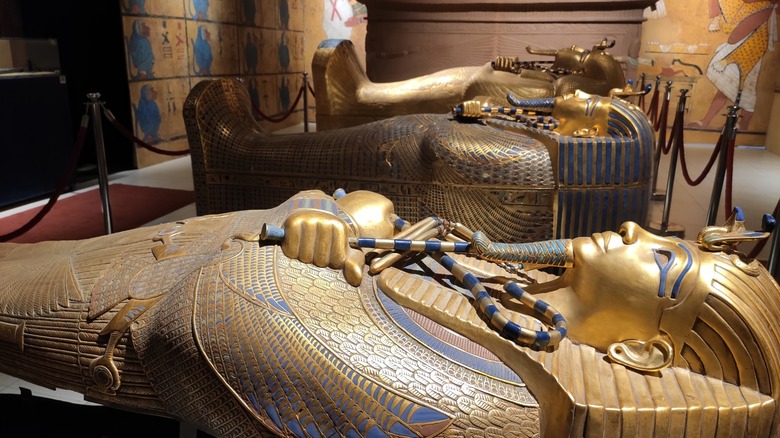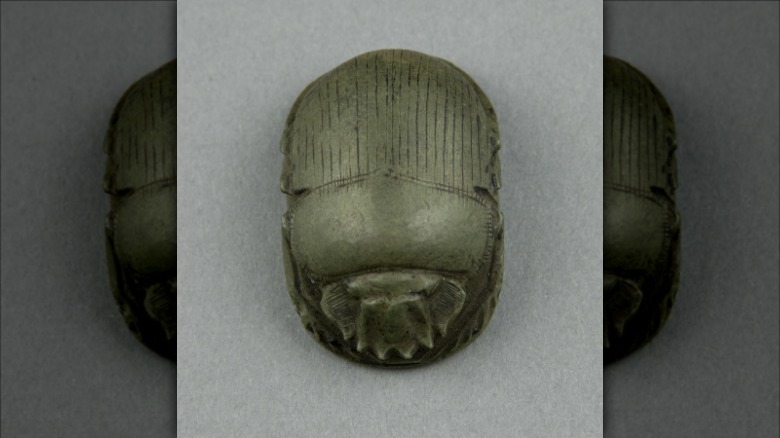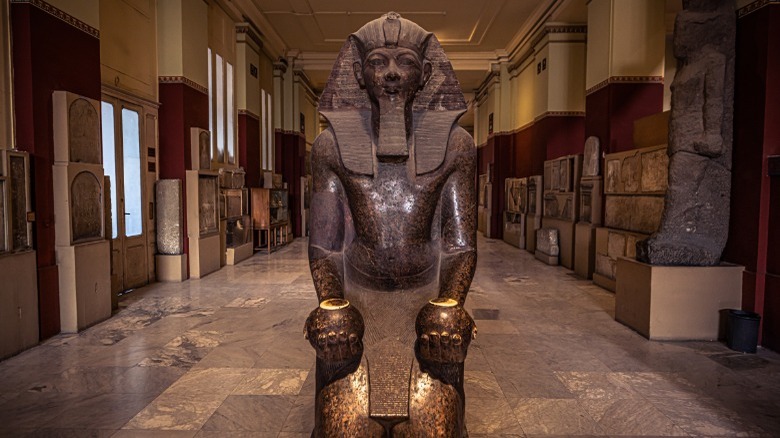What Digital Scans Of A Mummy Told Researchers About Egyptian Death Rites
A treasure trove of information on ancient Egyptian burial practices — and actual treasure — had been languishing in the basement of Cairo's Egyptian Museum until recently. The mummy of a teenage boy was discovered in 1916 at the Nag el-Hassay cemetery in Southern Egypt but was never examined. However, a new study explains that after the mummy's rediscovery, a team of researchers used computerized tomography (CT) scans to inspect the body without damaging, or even unwrapping, it. Their incredible discovery was that he was buried with 49 amulets made of gold and other precious materials, as well as a gold mask. He's now being called the "golden boy" (via CNN).
The Nag el-Hassay cemetery was used between roughly 332 B.C. and 30 B.C. Per CNN, the researchers estimate the "golden boy" died around 2,300 years ago. He, therefore, lived during Egypt's Ptolemaic period. It's believed he was roughly 14 or 15 when he died. This assessment was based on his bone fusion and the fact that his wisdom teeth hadn't yet emerged at the time of death (via Greek Reporter).
Interestingly, they also discovered that the boy was not circumcised as most ancient Egyptians were. This could mean he was foreign, possibly Persian, Nubian, or Greek. CNN notes that his outer coffin had Greek letters on it. However, per the Greek Reporter, his family may just not have followed typical cultural practices.
The golden boy's burial
Dr. Sahar Saleem wrote the study on the "golden boy." She's a professor of radiology at Cairo University. She described the embalming process the body would have experienced: "During mummification, the embalmers said prayers and recited verses from the 'Book of the Dead' while placing amulets inside the mummy or in between the wrappings" per Insider. She also explained other things her team found while examining the body. The "golden boy" had been wrapped in ferns. Ancient Egyptians had sacred associations with some plants and flowers, she said (via CNN).
The boy was wearing white sandals, which would allow him to walk out of his coffin in the afterlife, according to ancient Egyptian tradition. The white color was associated with piety and cleanliness, according to Saleem, quoted by CNN. However, Egyptian royalty was typically buried in golden sandals, according to Insider. Because the boy was buried with treasure but not in gold sandals, it suggests he was of a high social class but not royalty.
Insider interviewed Egyptologist Wojciech Ejsmond about this study, though he wasn't involved with it. Ejsmond is part of the Warsaw Mummy Project. He was enthusiastic about the study, saying it's "providing valuable information on how ancient Egyptians lived, died, and what they thought will happen next."
The meaning of the amulets
Among the amulets found with the golden boy were a right angle, a falcon, an ostrich plume, and a leaf-shaped tongue amulet, per CNN. Others were related to specific gods: he had an Isis knot, placing him under her care, and a Djed, representing Osiris' backbone (via Insider). In Ancient Egyptian culture, amulets helped give the dead tools and protection they would need for the afterlife. According to the Australian Museum, there were many different types of amulets with different meanings, and most corresponded to a specific part of the body where they needed to be placed. The Golden Boy's amulets would aid his rebirth after death and allow him to speak to the gods.
One of the amulets tied to his rebirth was the heart scarab in his chest cavity. Saleem explained that the heart scarab is mentioned in "The Book of the Dead." "It was important in the afterlife during judging the deceased and weighing of the heart against the feather of the goddess Maat," she explained. "The heart scarab silenced the heart on Judgement Day, so as not to bear witness against the deceased." (via CNN). She was so taken with it that she had a copy 3D-printed based on the CT scans. According to Live Science, this helped researchers see the words engraved on the scarab, including some from "The Book of the Dead."
Exhibit and further study
Saleem said the discovery of this mummy is "extraordinary," because it had been left untouched since burial (via Insider). Despite their detailed study of the body, her team didn't discover his cause of death or his identity, beyond being upper-class and possibly foreign, per CNN. They are continuing their studies to explore who he may have been, according to Insider.
Ejsmond says he's particularly interested in the time period the boy would've come from. He would have been "the eyewitness of the dusk of the ancient Egyptian civilization, possibly the turmoils during the time of the last Ptolemaic kings, and perhaps even a short revival of Egypt's greatness during Cleopatra's reign," he said (via Insider).
The "golden boy," still in his wrappings, is now on display in the main exhibition hall of Cairo's Egyptian Museum. The display also includes CT images of him and a copy of the heart scarab. The exhibit is designed to help visitors learn more about Ancient Egyptian burials (via CNN).



